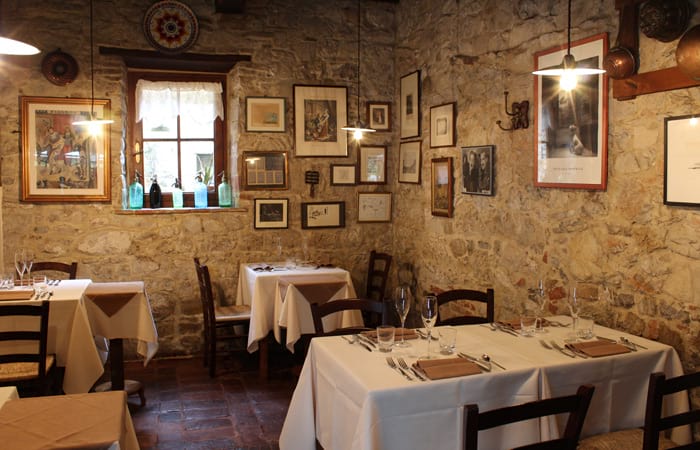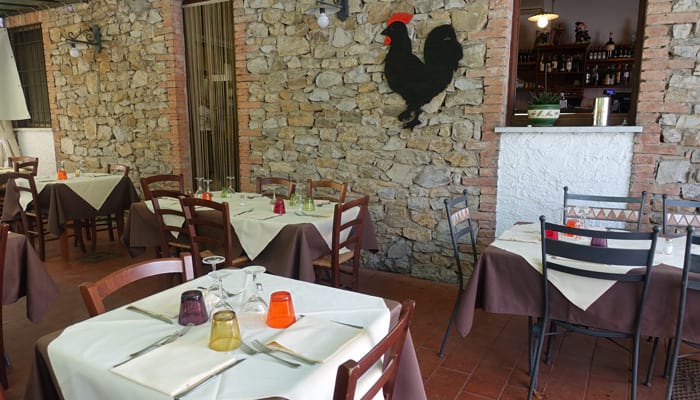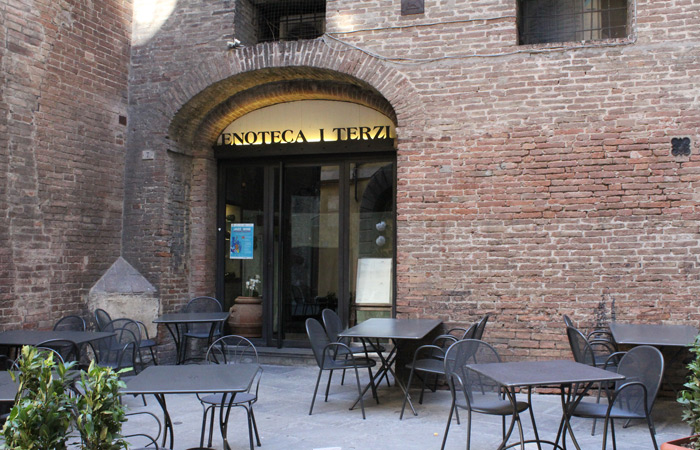Where to Eat and Drink
Tuscany is rich not only on art and history but also on culinary and oenological traditions. Everywhere you go in Tuscany there is an abundance of fine wine and food. You will discover that every small district within Tuscany has its own culinary traditions and version of general Tuscan dishes. The beauty lies in exploring the many aspects of local food culture and all the tiny differences among the different areas. Do not miss out on tasting the local Tuscan specialities on your dream vacation in Tuscany.
Try and not be confused by the many different levels of restaurants you can find in Tuscany and in Italy. Even though they can be of varying levels of refinement you will discover that the vast majority always serves excellent Tuscan food. This in combination with the quality of the wine that is renowned worldwide.
On your dream adventures all over Tuscany you can come in contact with the following type of food places:

Traditional cooking
Soups: Ribollita | Pappa al pomodoro.
Pasta: Pici alla cinta senese.
Meat: Fiorentina | Tagliata.
Cheese: Percorino.
Salami: Prosciutto toscano | finocchiona.
Mushrooms: Truffle | porcini.
Cookies: Ricciarelli | Cantuccini.
It is said that Tiramisù was invented in Toscana, amongst may other places in Italy
Soups:
‘Ribollita’ – A dish made primarily from beans, carrot, potato, black cabbage, vegetable stock, herbs, salt, pepper and bread. The recipe for this may vary slightly throughout the region and from ‘Mamma’ to ‘Mamma’ but is a winter dish where every vegetable available might go into the pot! Once the ‘Ribollita’ is made, it is served either with the bread, (usually yesterday’s) served cubed, toasted and thrown in afterwards or the sliced toasted bread is used to line a dish and the soup poured over it. Once made ‘Ribollita’ lasts well for several days in the fridge and can form a main meal or a tasty warming snack!
‘Pappa al Pomodoro’ – Another simple dish of tomato, bread, garlic, salt, pepper, vegetable stock and basil. ‘Pappa al pomodoro’ is very tasty and beloved of parents, as children will gobble it down with relish! So popular for using up old bread and feed small persons, there have been songs made about it! Notably from the televised 1960’s series based on the ‘Diary of Gian Burrasca’ a popular children’s character set in the 1910’s.
Pasta:
‘Pici alla Cinta Senese’ – ‘Pici’ are a very thick long pasta, (a sort of very fat spaghetti) made from water and ‘00’ grade durum flour. Served very ‘al dente’ with a sauce or ‘ragù’ made from the famous ‘Cinta Senese’ swine. The swine are a half wild breed that indeed, look not unlike their cousins the forest swine or ‘wild boar’ that roam freely in the forests of the Chianti and throughout Italy. However, the ‘Cinta Senese’ swine often have a white ‘saddle’ over their shoulders of varying size and black hair. Also being an ancient breed, they are even depicted in the frescoes of Lorenzetti in the ‘Palazzo Publicco’ in Siena. Today the breed is apparently on the wane, probably being so tasty, so many have been turned into hams, sausages, black pudding and ‘salame’!
Meat:
Talking of flesh onto the meatier side of Tuscany!
Although well known for loving their fresh vegetables, Tuscans away from the coast of Tuscany are almost born carnivores, not to say that a trip to the seaside will not disappoint anyone wanting fish or seafood! The Tuscan countryside has also produced a distinct breed of cattle and sheep that produce sweet milk; the forests, vineyards and olive groves harbour much game and hunting is a ‘BIG’ thingfor many Tuscans. There is also much to forage for too, the season for mushrooms brings in several species from ‘Porcini’ (boletus Edulis and family) mushrooms and truffle hunting with trained hounds and sometimes pigs. The latter unfortunately, sometimes have a habit of eating the prize before the handler can retrieve it!
‘Chianina’ Cattle – This breed of cattle really cannot be mistaken for any other! Bred in the Tuscan countryside as draught animals to pull ploughs and in the old days huge carts piled high with the huge straw bound glass flasks, filled with the labour of love, the ‘Vino di Chianti’. These beasts are huge, bigger than many other breeds of cattle, white in colour with dark muzzles, eyelashes and with large sweeping horns, they are still used to pull the carts in the parade before the famous horse race in Siena – the ‘Palio’. Aside from the ability to haul loads, the breed is also very hardy, despite their size, that can tolerate heat, drought, cold and live off scrub too, so a hardy viable animal which is now found throughout the world thanks to modern breeding methods! So valuable, that a breed stock register is kept in Tuscany and through cross breeding with other famous beef cattle like the ‘Scottish Black Angus’ a hybrid has been created the ‘Chiangus’! The reason for this, is that despite being a draught animal the original ‘Chianina’ is also very tasty!
Hence:
‘Chianina’ Steak – Also known as the ‘Fiorentina’ Steak. A ‘T’-bone steak usually about one and a half kilos in weight, about 53oz on average. Always cooked ‘alla brace’ grilled over oaken embers, the steak is briefly seared for about five minutes each side, then cooked on end through the bone. Served on a platter with the meat cut from and placed around the up ended bone and surrounded by baked potatoes, this is a signature dish from Tuscany for one, or perhaps more if you really think you can’t manage it on your own! Naturally washed down with Chianti wine or perhaps a moreish ‘Brunello’?
Of course, one can get far more out of a ‘Chianina’ other than ‘T’-bone steak but go to a good ‘Macelleria’ (butcher) and have a look, for example ‘tagliata’ meaning ‘cut’ another tasty bit of steak, grilled to your likingwith plenty of the aromatic ‘Rosmarino’ herb, (although other herbs can are used for flavour) and served with ‘Patate al Forno’ (roasted potatoes with garlic, rosemary and salt), the flesh is served ‘cut’ into strips, hence the name of the dish!
Having mentioned game and hunting, we come to:
‘Cinghiale’ – forest swine or better known as ‘wild boar’. Like its cousin the domesticated pig, ‘Cinghiale’ once tracked down and shot by one of the many enthusiastic Tuscan hunters, the ‘wild cousin’ will be turned into a myriad of tasty dishes. ‘Salame’, blood sausages (black pudding) and hams. One dish involving almost three days of very slow cooking with Cocoa and lots of Chianti wine is probably the very essence of ‘slow food’ and awesomely, deliciously, Tuscan.
Other game includes ‘Lepre’ (Hare) and a dish so deliciously Tuscan is ‘Pappardelle con ragu di Lepre’. We really should pop this under ‘pasta’ above, as ‘Pappardelle’ are a wide flat egg pasta and the hare ‘ragù’ is another example of the deliciously simple sauces from this region.
Cheese:
‘Pecorino’ – Made from the milk of the local sheep in the region of Siena and especially famed for it in Pienza. ‘Pecorino’ comes in several stages of maturing. The young cheeses, ‘Fresco’ are sweet and acidic and are often served with honey as a traditional starter or finish to a meal. The next aged cheeses are ‘Semi Stagionato’ or ‘half aged’ and have a firmer body and slightly stronger flavour. The ‘Stagionato’ or ‘old’ cheeses are very firm, almost hard but have a deliciously nutty yet creamy taste, often worth munching with some good wine. The aged ‘Pecorino Toscano’ is a rival to ‘Parmigiano Reggiano’ and can be used in place of that cheese grated over pasta dishes.
Salami:
One famous ‘Salami’ to have come from the Siena area is ‘Finocchiona’. Lore has it that, when the Senese were finally subdued by the Florentines, the victors imposed a harsh tax on the black pepper the Senese used to cure and flavour their sausages with. Already an expensive enough spice, the pepper in those days came all the way from Indonesia, the Senese where not to be outdone by their historical rivals. So, they looked for something else which they found all around them in Tuscany - ‘Finocchio’ or fennel, thus a new delicacy was created that enabled them to have their ‘salame’ as delicious as before and thumb their noses at the Florentines by not having to pay any taxes on their sausages!
Ham:
‘Prosciutto Toscano’ – Tuscany like many places in Italy produces pigs and, although hams have been produced in Tuscany for hundreds of years, it was about the time of the Medici when records first appeared regulating the production of cured hams to ensure quality and protect sources. These days ‘Prosciutto Toscano’ has ‘DOP’ - ‘Denominazione d’Origine Protetta’ - (protected designation of origin) status, thus only porkers raised in Tuscany from specific breeds can be turned into the famous ham. Using sea-salt, juniper, black pepper and rosemary massaged into the prepared ham it is then air dried, the local microclimate being ideal for the curing process. ‘Prosciutto Toscano’ is usually eaten finely sliced which brings out its delicate flavour, somewhat surprising from a ham that is low in fat and deep red in colour!
Cookies:
‘Ricciarelli’ – A type of almost but not quite meringue / cookie / biscuit originally from Siena. Made from egg white, sugar and almond flour these absolutely yummy, scrumptious biscuits have the appearance of cracked eggshells, the white and almost crunchy outer shell showcasing the golden chewy interior through the cracks. After a morning slog around the shops or on completing a morning tour, too early for a beer or for lunch - these are a delicious almond ‘n’ sugar ‘hit’ fabulous with an ‘espresso’, ‘macchiato’ coffee or even a good cup of tea, Earl Grey being a great companion! Introduced to Siena, apparently by some chap called ‘Ricciardetto’ home from the crusades, ‘Ricciarelli’ are similar to French ‘Macarons’ using very similar ingredients but in different proportions.
‘Cantuccini’ – also known as ‘Biscotti’ which means ‘biscuit’ in Italian, also meaning ‘twice cooked’ and there is a reason that ‘Cantucci’ or ‘Cantuccini’ are baked twice! Originating from Prato in Tuscany, North of Florence, ‘Cantucci’ are small hard cookies made from flour, eggs, sugar and whole almonds, sometimes the almonds are substituted with pine nuts. The dough is baked in the form of a low flat loaf which is then sliced into cookies which are baked again for a few more minutes. Straight from the oven they are not ‘hard’ but soft and very aromatically delicious, but they become hard very quickly as the baking process is to prolong shelf life. If the cookie jar is not emptied immediately the ‘Cantuccini’ will last a long time, hopefully for as long as it might take to produce the sweet wine, ‘Vin Santo’ they are traditionally dunked in before being eaten!
‘Panforte’ – the literal translation of ‘Panforte’ is ‘strong bread’ but it can be quite hard too. There appear to be several ideas as to the origin of ‘Panforte’. It is a spiced, honeyed, candied fruit and nut filled dense ‘cake’, the recipe for which, was brought back by Crusaders returning from Turkey. Another idea is that it was a form of ‘tribute’ given by peasants to the nuns of a certain nunnery, however given the high content of ‘expensive’ spices involved in producing this cake, this is probably unlikely. Another is that it is Senese in origin and originally called ‘Panpepato’ in reference to the black pepper used to dust the baked article. The current, sweeter ‘white sugar’ dusted version known today appears to have been created to celebrate the arrival of Queen Margherita of Savoy in 1879. The recipe for the original ‘cake’ had apparently remained unaltered until then. Made by the ‘spicers’ of the day, who were also the local apothecaries, it was offered by the wealthy on special occasions and at Christmas, being so full of expensive spices, it was not universal until much later and although originally associated with Christmas it is now made all year. Many now make it at home and there are many varying recipes for it, but like the ‘Ricciarelli’ above, it is also mind bogglingly delicious with coffee or tea!
‘Tiramisu’ – Many places in Italy make the claim that they invented ‘Tiramisu’ meaning ‘pick me up’ or ‘pull me up’, though found in many ‘ristoranti’ in Tuscany, it is thought its origin is Treviso in Veneto, Northern Italy. Being based on ‘Mascarpone’, a soft dairy cheese originating in Lombardy, makes it more likely so, (in Italy generally it’s dairy in the North and olive oil in the South). Eggs, a lot of sugar, ‘Savoiardi’ Biscuits for the Savoy Family (who were opponents of Austria and ardent unifiers of what was to become the Italian State), making it a ‘patriotic’ dish. The recipe includes cocoa, coffee and maybe an alcohol for flavouring. Being full of sugar and eggs, this dessert’s name is most appropriate.

IL RISTORANTE
Il Ristorante - it is a restaurant that usually offers high quality and not necessarily seasonal food in often a bit more formal surroundings. It is a place with waiter service and quite often signature dishes of the chef. A place best for a nice dinner or to celebrate a special event.
LA TRATTORIA
La Trattoria - it is still a restaurant but simpler in character that often serves seasonal and local dishes. Still, with waiter service but overall far cheaper than a more formal restaurant.


L'ENOTECA
L’Enoteca - it is a place where local wines as well as wines from other parts of Italy may be sampled. Occasionally, you can find that they organize tastings or evenings with local wine producers as a way to draw attention to their products and attract new customers and tourists. An enoteca has a good selection of wine and often also pair it with snacks based on local food products.
Nowadays in Tuscany there is also very refined cooking developed by local Chefs who base their cooking on traditional ingredients but elaborate their dishes to the highest level of fine cooking.